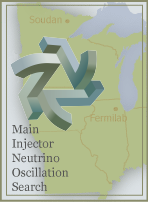- νμ DISAPPEARANCE - OSCILLATION PARAMETER MEASUREMENT USING BEAM AND ATMOSPHERIC DATA
- This figure shows the 90% confidence level contours for the neutrino oscillation parameters obtained by MINOS and other experiments. The MINOS analysis uses all νμ and νμ charged current interactions, assuming identical oscillation parameters for neutrinos and antineutrinos. The black line shows the 90% CL contour obtained from a combined analysis of the MINOS beam and atmospheric neutrino data. The red line shows the analysis of MINOS beam data only. These results are compared to the the measurements from Super-Kamiokande (blue) and T2K (green). The best fit point for the MINOS combined analysis is Δm2=(2.39+0.09-0.10 )x10-3 eV2, sin2(2Θ)=0.957+0.035-0.036, or sin2(2Θ) > 0.90 (90% CL). A tabular form of the likelihood surface from this analysis can be found here as a csv file, which lists sin2(2Θ), Δm2 and Δln(L) in three columns. The likelihood surface is also available here as a ROOT file.
Published Results
- a listing of all journal publications by the MINOS collaboration
- a listing of theses written by MINOS graduate students, available as a web page with links or a text list
The Public Materials Page provides downloadable PDF files of plots and diagrams from recent results, formatted as presentation slides. These files are released by MINOS for public use by non-MINOS scientists. All have been presented at recent conferences and represent published or soon-to-be published results. Updated June 2012
Highlights from Recent Results
Plots and brief explanatory text for recent MINOS results. All plots shown here are available as downloadable PDFs on the Public Materials page. Click on the plot image for a full-page version.
- νμ DISAPPEARANCE - ANTINEUTRINO OSCILLATION MEASUREMENT USING BEAM AND ATMOSPHERIC DATA
- This figure shows the 90% confidence level contours for the antineutrino oscillation parameters. The black line shows the 90% CL contour obtained from the combined analysis of all the MINOS beam and atmospheric neutrino data, allowing the neutrino and antineutrino oscillation parameters to float independently. Also shown are the MINOS antineutrino measurements using beam data only (red) and atmospheric data only (blue), as well as the Super-Kamiokande antineutrino measurement (dashed). The best fit antineutrino oscillation parameters obtained by the MINOS combined analysis are Δm2=(2.48+0.22-0.27 )x10-3 eV2, sin2(2Θ)=0.97+0.03-0.10, or sin2(2Θ) > 0.83 (90% CL). A tabular form of the likelihood surface from this analysis can be found here as a csv file, which lists sin2(2Θ), Δm2 and Δln(L) in three columns. The likelihood surface is also available here as a ROOT file.
- νμ DISAPPEARANCE - OBSERVED SPECTRA OF BEAM AND ATMOSPHERIC NEUTRINOS
- This figure shows the observed distributions of muon neutrino and muon antineutrino charged-current interactions in the MINOS Far Detector. The top row of graphs shows the energy spectra for MINOS beam data, the bottom row shows the L/E distributions for MINOS atmospheric data. In each case, the black line shows the prediction without oscillations; the red line shows the best fit to oscillations; and the black points show the observed data.
- νe APPEARANCE ANALYSIS - LIMITS and BOUNDS
- νe events appearing at the Far Detector can be used as a measure of the θ13 mixing angle. The plots show the allowed ranges and best fits for 2sin2(2θ13)sin2(θ23) as a function of the CP-violating phase δ. The upper (lower) panel assumes the normal (inverted) neutrino mass hierarchy. (The value of δ and the mass hierarchy are fixed in the fit). This fit combines data taken in the neutrino-enhanced and antineutrino-enhanced beam modes. The contour is available here as a ROOT file along with a description of the contents.





